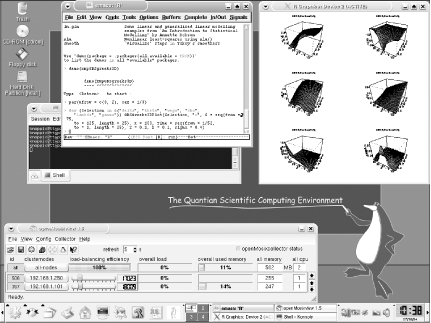Hack 90 Analyze Quantian
| < Day Day Up > |
Hack 90 Analyze Quantian Quantian is an extension of Knoppix and ClusterKnoppix tailored to numerical and quantitative analysis . The Quantian live DVD distribution (http://dirk.eddelbuettel.com/quantian.html) adds a quantitative facet to Knoppix. Based on ClusterKnoppix [Hack #89] , Quantian adds software with a quantitative, numerical, and scientific focus: several computer-algebra systems; higher-level matrix languages; data-visualization tools; a variety of scientific, numeric, and engineering applications, as well as many different programming languages and libraries. A particular focal point is the R language and an environment for statistical computing. With its unique combination of the Knoppix-based ease of use and the additions of both openMosix cluster computing and a very rich set of scientific packages, Quantian can be of immediate use. It can:
The first two Quantian releases were based directly on Knoppix. Since then, ClusterKnoppix has provided the basic building block, which, similar to Knoppix itself, provides various utilities, games , multimedia applications, a complete KDE environment with its window manager, a browser, an office suite, a development environment and editors, as well as a large number of other general-purpose tools, utilities, and diagnostic applications. Quantian then adds various sets of applications from different areas:
Quantian isn't limited to these applications. Quantian also provides instant openMosix clustering with fully automatic configuration (see [Hack #89] ), as well as the ability to let other machines boot over the network (in the openmosixterminalserver mode) and become additional cluster nodes. Moreover, through the addition of suitable libraries and applications for the pvm and lam / mpich message-passing interfaces, Quantian also provides Beowulf clustering support. Both openMosix and Beowulf styles of distributed computing can be combinedfor example, multiple pvm or pvm node clients can be started on a single host in order to let openMosix spread the load most efficiently across the cluster (see Figure 8-4). Figure 8-4. Quantian managing a cluster 8.12.1 See Also
Dirk Eddelbuettel |
| < Day Day Up > |